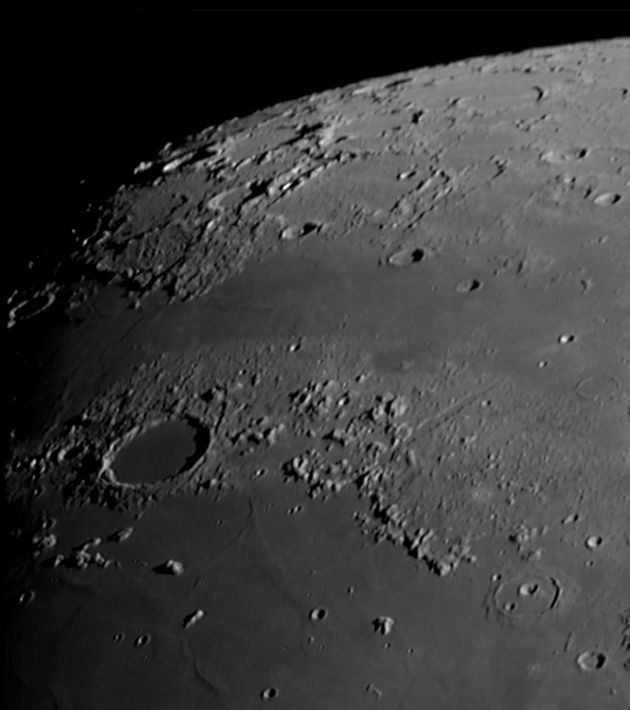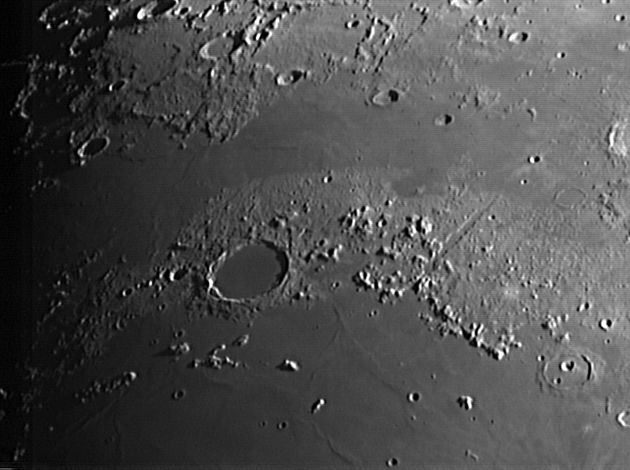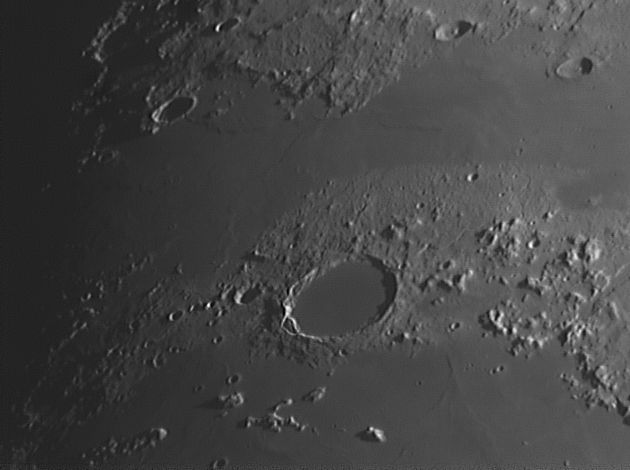Mare Frigoris 
Move your mouse over the picture to see the names of the various features.

|
This is a composite of two images of this area taken when the libration was about as
unfavourable as it gets. Mare Frigoris (Cold Sea) is the northernmost mare on the Moon
and is bordered to the south by the Jura Mountains in the west and the Alps in the east.
To the north is a rugged area with many large, ancient craters such as W C Bond, Birmingham,
and Meton, which date back some 4,000 million years. Anaxagoras, on the other hand, is
very young at less than 1,000 million years. The difficulty observing this area means that
although the sizes of these craters are known (Meton for example is 125 Km in diameter), their
depths are largely unknown. South of the Mare Frigoris lies Plato, 105 Km in diameter but
probably only about 1000 metres deep, its floor having been flooded with lava relatively recently.
To the east is the Alpine Valley, a feature 150 Km long and about 8 Km wide. Down
its centre, not resolved in this picture, runs a narrow rille about 700 metres wide. South
of Plato is the northern part of Mare Imbrium with the Teneriffe Mountains and the isolated Mount
Pico. Pico is interesting. There are craters named Pico A , Pico B etc., but there
is no crater Pico––Pico is a mountain, just south of which is a nice little linear mountain
with the rather boring name of β.
It is impossible to show realistic scale markers for a picture so near the pole. The markers are very
approximately 100 km long north and east and apply to the region of Plato. The effect of perspective
is clear from the different lengths of these two markers (Plato is circular) and the effect gets dramatically
greater as one goes north (Anaxagoras is also circular). I have marked where I think the North pole is, but
it must also be remembered that the lines of longitude will be curved.
The picture was taken with a ToUcam attached to my LX200 on 19th March 2005, when the Moon was 9.1 days old.
|
| Date and Time |
19th March 2005 19:40 UT |
| Camera |
ToUcam 740K |
| Telescope |
LX200 at prime focus |
| Capture |
K3CCDTools. High gamma, 1/100", 9% gain, 308 frames |
| Processing |
Registax. 74 frames stacked. Wavelet 1-2 = 10 |

|
This is a slightly wider-angle picture of the southern part of the picture above. However the libration was very different. In the picture above, the libration was -6° 24' in latitude and +0° 53' in longitude, whereas here it is +2° 59' in latitude and -1 51' in longitude. So relative to the picure above, the Moon is tipped 9° south and 2° west.
The scale markers correspond approximately to 100 Km north and east and apply at Plato.
The picture was taken with a ToUcam attached to my ETX125 on 15th July 2005, when the Moon was 8.5 days old.
|
| Date and Time |
15th July 2005 18:30 UT |
| Camera |
ToUcam 740K |
| Telescope |
ETX125 at prime focus |
| Capture |
K3CCDTools. Low gamma, 1/25", 15% gain, 498 frames, infra-red light |
| Processing |
Registax. 296 frames stacked. Wavelet 1-3 = 10, contrast 180, brightness -76 |

|
This is a slightly narrower-angle picture of the same general area as the picture above. The libration was fairly neutral, at 0° 57' in latitude and -1° 51' in longitude.
The scale markers correspond approximately to 100 Km north and east and apply at Plato.
The picture was taken with a ToUcam attached to my LX200 on 5th June 2006, when the Moon was 9.0 days old.
|
| Date and Time |
5th June 2006 17:51 UT |
| Camera |
ToUcam 740K |
| Telescope |
LX200 at prime focus with IR-pass filter |
| Capture |
K3CCDTools. Low gamma, 1/25", 22% gain, 609 frames, infra-red light |
| Processing |
Registax. 122 frames stacked. Wavelet 1 = 10 |
Home Back to NW Quadrant



